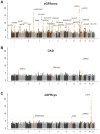Multiple loci associated with indices of renal function and chronic kidney disease
- PMID: 19430482
- PMCID: PMC3039280
- DOI: 10.1038/ng.377
Multiple loci associated with indices of renal function and chronic kidney disease
Abstract
Chronic kidney disease (CKD) has a heritable component and is an important global public health problem because of its high prevalence and morbidity. We conducted genome-wide association studies (GWAS) to identify susceptibility loci for glomerular filtration rate, estimated by serum creatinine (eGFRcrea) and cystatin C (eGFRcys), and CKD (eGFRcrea < 60 ml/min/1.73 m(2)) in European-ancestry participants of four population-based cohorts (ARIC, CHS, FHS, RS; n = 19,877; 2,388 CKD cases), and tested for replication in 21,466 participants (1,932 CKD cases). We identified significant SNP associations (P < 5 × 10(-8)) with CKD at the UMOD locus, with eGFRcrea at UMOD, SHROOM3 and GATM-SPATA5L1, and with eGFRcys at CST and STC1. UMOD encodes the most common protein in human urine, Tamm-Horsfall protein, and rare mutations in UMOD cause mendelian forms of kidney disease. Our findings provide new insights into CKD pathogenesis and underscore the importance of common genetic variants influencing renal function and disease.
Figures



References
-
- Levey AS, et al. Chronic kidney disease as a global public health problem: approaches and initiatives - a position statement from Kidney Disease Improving Global Outcomes. Kidney Int. 2007;72:247–259. - PubMed
-
- Serafini-Cessi F, Malagolini N, Cavallone D. Tamm-Horsfall glycoprotein: biology and clinical relevance. Am J Kidney Dis. 2003;42:658–676. - PubMed
-
- Coresh J, et al. Prevalence of chronic kidney disease in the United States. JAMA. 2007;298:2038–2047. - PubMed
Publication types
MeSH terms
Substances
Grants and funding
- K01 DK067207/DK/NIDDK NIH HHS/United States
- R01 HL086694/HL/NHLBI NIH HHS/United States
- N01-HC-85086/HC/NHLBI NIH HHS/United States
- UL1 TR000423/TR/NCATS NIH HHS/United States
- N01 HC045133/HC/NHLBI NIH HHS/United States
- N01 HC035129/HC/NHLBI NIH HHS/United States
- R01HL086694/HL/NHLBI NIH HHS/United States
- UL1RR025005/RR/NCRR NIH HHS/United States
- N02-HL-6-4278/HL/NHLBI NIH HHS/United States
- N01-HC-25195/HC/NHLBI NIH HHS/United States
- N01 HC055022/HC/NHLBI NIH HHS/United States
- N01 HC085086/HC/NHLBI NIH HHS/United States
- N01 HC055016/HL/NHLBI NIH HHS/United States
- N01 AG012100/AG/NIA NIH HHS/United States
- N01 HC055019/HL/NHLBI NIH HHS/United States
- N01-HC-85085/HC/NHLBI NIH HHS/United States
- R01HL59367/HL/NHLBI NIH HHS/United States
- UL1 RR025005/RR/NCRR NIH HHS/United States
- U01 HL080295/HL/NHLBI NIH HHS/United States
- HL 043851/HL/NHLBI NIH HHS/United States
- N02 HL064278/HL/NHLBI NIH HHS/United States
- N01 HC075150/HC/NHLBI NIH HHS/United States
- N01-HC-55022/HC/NHLBI NIH HHS/United States
- N01-HC-85081/HC/NHLBI NIH HHS/United States
- R01 HL043851/HL/NHLBI NIH HHS/United States
- R01 HL059367/HL/NHLBI NIH HHS/United States
- N01 HC055021/HL/NHLBI NIH HHS/United States
- N01 HC015103/HC/NHLBI NIH HHS/United States
- N01-HC-55016/HC/NHLBI NIH HHS/United States
- M01 RR000069/RR/NCRR NIH HHS/United States
- N01 HC085086/HL/NHLBI NIH HHS/United States
- N01 HC055018/HC/NHLBI NIH HHS/United States
- N01 HC025195/HC/NHLBI NIH HHS/United States
- N01 HC055015/HL/NHLBI NIH HHS/United States
- R01 HL087652/HL/NHLBI NIH HHS/United States
- N01-HC-55021/HC/NHLBI NIH HHS/United States
- HHSN268200625226C/PHS HHS/United States
- U01 HG004402/HG/NHGRI NIH HHS/United States
- U01HG004402/HG/NHGRI NIH HHS/United States
- CA 047988/CA/NCI NIH HHS/United States
- N01 HC055020/HL/NHLBI NIH HHS/United States
- K01DK067207/DK/NIDDK NIH HHS/United States
- N01-HC-85082/HC/NHLBI NIH HHS/United States
- N01 HC055019/HC/NHLBI NIH HHS/United States
- P30 DK063491/DK/NIDDK NIH HHS/United States
- N01-HC-55019/HC/NHLBI NIH HHS/United States
- N01 HC025195/HL/NHLBI NIH HHS/United States
- R01HL087641/HL/NHLBI NIH HHS/United States
- N01-HC-55015/HC/NHLBI NIH HHS/United States
- N01 HC055222/HL/NHLBI NIH HHS/United States
- N01 HC055222/HC/NHLBI NIH HHS/United States
- N01-HC-55222/HC/NHLBI NIH HHS/United States
- M01RR00069/RR/NCRR NIH HHS/United States
- N01 HC085079/HL/NHLBI NIH HHS/United States
- N01-HC-85083/HC/NHLBI NIH HHS/United States
- N01-HC-75150/HC/NHLBI NIH HHS/United States
- N01-HC-55020/HC/NHLBI NIH HHS/United States
- N01-HC-85080/HC/NHLBI NIH HHS/United States
- R01 DK076770/DK/NIDDK NIH HHS/United States
- N01 HC055015/HC/NHLBI NIH HHS/United States
- ImNIH/Intramural NIH HHS/United States
- R01 AG027002/AG/NIA NIH HHS/United States
- N01 HC055021/HC/NHLBI NIH HHS/United States
- N01 HC055018/HL/NHLBI NIH HHS/United States
- R01 CA047988/CA/NCI NIH HHS/United States
- KL2 RR025015/RR/NCRR NIH HHS/United States
- DK063491/DK/NIDDK NIH HHS/United States
- N01-HC-85079/HC/NHLBI NIH HHS/United States
- N01 HC055022/HL/NHLBI NIH HHS/United States
- N01 HC055020/HC/NHLBI NIH HHS/United States
- N01 HC085079/HC/NHLBI NIH HHS/United States
- N01 HC075150/HL/NHLBI NIH HHS/United States
- N01-HC-55018/HC/NHLBI NIH HHS/United States
- R01 HL087641/HL/NHLBI NIH HHS/United States
- N01 HC055016/HC/NHLBI NIH HHS/United States
- N01-HC-85084/HC/NHLBI NIH HHS/United States
LinkOut - more resources
Full Text Sources
Other Literature Sources
Medical
Molecular Biology Databases
Miscellaneous

